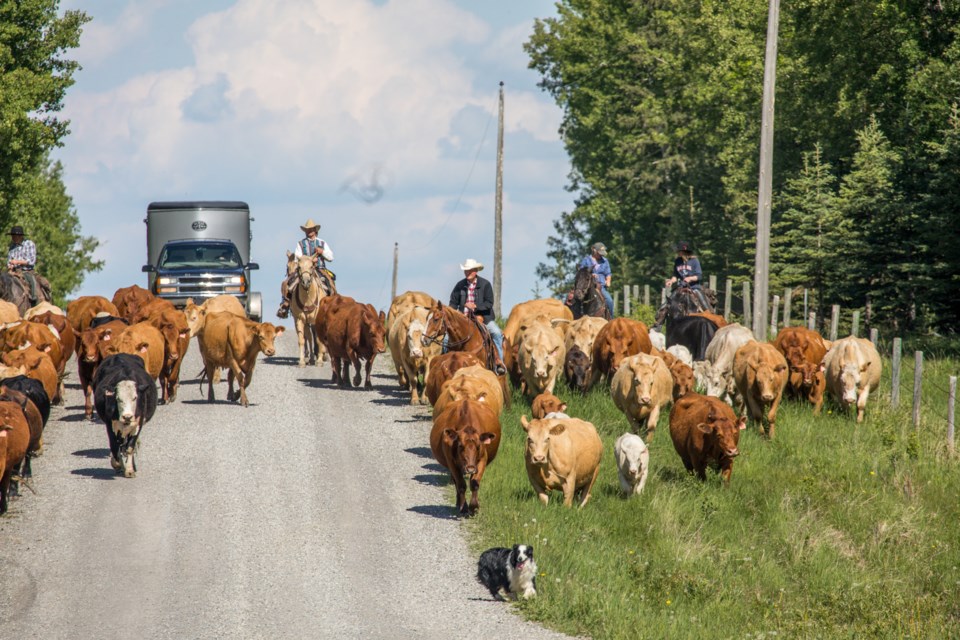Since the open range period of development at the turn of the 20th century first brought the cattle industry as we know it today to western Canada, there have always been those looking to make a quick buck off the theft and sale of cows.
According to the RCMP, cattle rustling has been on the rise in Alberta the past few years.
Cpl. Lindsey Anderson of the RCMP’s Livestock Investigations Unit said instances of cattle rustling generally rise and fall with the price of beef.
“Cattle rustling is still a thing,” explained Anderson in a recent interview with the Rocky View Weekly. “You definitely have to know what you are doing, and have the ability (as a rustler) to go around and round cattle up with an ATV or a horse. You also have to have the ability to transport them.
“This year we have had more reports of missing or stolen livestock,” she confirmed. “I think part of that would, potentially, be contributed to the current beef prices, where a handful of livestock do go missing.”
While there have been some high profile thefts of animals in Alberta in the past year– one Westlock area farmer reported 85 cattle taken last fall, including two 900-kilogram bulls, four cows and 79 calves– Anderson said rustling on a larger scale is incredibly rare these days. Most cattle thefts reported in Alberta only involve one or two head, she confirmed.
With these smaller scale crimes, Anderson said it is likely the stolen animals are being slaughtered and processed for beef– either for private sale or personal usage.
According to Anderson, with the rarer crimes involving numerous animals, as in the case of the Westlock farmer, those animals were likely transported out of the province to eastern Canadian markets for a quick sale.
Anderson said the problem is once you take animals out of British Columbia, Alberta or Saskatchewan there is no system of brand inspection required before sale.
“Branding your livestock is the primary means of ownership verification,” she explained. “If we do go out and recover something, the brands are going to be what we are looking for to prove those animals belong to you … If Manitoba and the rest of the country (eastward) were on board with brand inspection, it would make the theft and sale of cattle a lot more difficult.”
Farms in Alberta also use ear tags on cattle for better market and food chain traceability in the case of outbreaks of diseases, etc. These ear tags can also be useful in helping to trace stolen livestock sometimes, confirmed Anderson; however, they can also be easily clipped out and replaced. And so, according to Anderson, using a registered brand on animals is still the best way to make it harder for rustlers to profit.
“In order to apply a brand to your livestock, it has to be registered,” she explained. “In Alberta we have Livestock Identification Services. So you have to make the application to make sure the brand is registered at one of six locations on cattle, whether its hot iron or freeze brand. Then that brand is registered to you for a lifetime.”
Anderson said the three western provinces maintain a common database of registered brands; so cattle crossing those borders can be more easily traced.
“Those three entities do a really good job of maintaining databases for ownership identification,” she confirmed. “They also work together. So if you have some cattle that has come into Alberta from Saskatchewan, for example, the brand inspectors here will be able to identify those brands.”
Besides branding, Anderson also recommended that cattle producers be more proactive in their own operations by keeping good records of their cows, and by carrying out daily inspections and head counts on their herds; especially while they are out in summer pastures.
They should also, she said, take extra steps to prevent rustling when they hear of suspicion persons or vehicles near their farms.
“If there is a problem location, you can set up a trail camera and do what you can on your end to be proactive,” explained Anderson. “If you notice any suspicious persons or vehicles in the area, they can be recorded. If anything is being stolen, they might be caught on camera.”
According to statistics provided by the Alberta RCMP, there have been no reported cases of cattle theft so far in the Cochrane, Airdrie or Strathmore detachment areas in 2023.
In 2022, Cochrane reported one case of suspected cattle rustling. And in 2021, Cochrane and Airdrie each reported one case of suspected cattle rustling.




